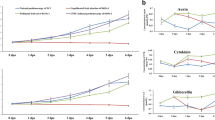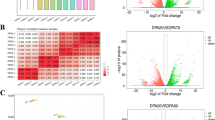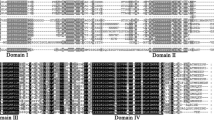Abstract
Although most cucumber varieties have certain parthenocarpy abilities, fruit development will still be significantly inhibited at low temperature. Therefore, it is of great significance to study the molecular mechanism of parthenocarpy regulated by low temperature and to excavate low temperature-tolerant parthenocarpic gene resources, for stable production under low-temperature stress. ‘EC5’ is a low temperature-induced parthenocarpy (LT-P) line identified by previous screening. In this study, the effect of hormones on the development of the LT-P fruit was studied by transcriptome analysis and endogenous hormone determination under two different temperature conditions. It was found that there were few differentially expressed genes between ovaries before anthesis (230 ~ 460 DEGs). However, after anthesis, the number of DEGs increased sharply, following 1, 372 DEGs at 1 day after anthesis (DAA), 6, 272 DEGs at 2 DAA, and 9, 119 DEGs at 3 DAA, respectively. At 2 DAA, DEGs were significantly enriched in the plant hormone signal transduction pathway (Ko 04075); 25% and 19% of the genes were involved in auxin and ethylene metabolism and signaling, respectively. Endogenous hormone determination indicated that the accumulation of IAA and ACC showed an inverse curve during fruit development: IAA accumulated continuously, while ACC synthesis was inhibited during parthenocarpy under low temperature. During fruit abortion at room temperature, the IAA metabolism level decreased sharply, and ACC synthesis increased. Those were consistent with the results of transcriptome analysis that auxin-related genes were significantly up-regulated, and ethylene-related genes were significantly down-regulated. qRT-PCR analysis indicated that some key auxin-related genes had an opposite expression trend compared with ethylene-related genes under two temperature conditions. Exogenous applications of auxin and ethylene showed that auxin promoted parthenocarpy while ethylene inhibited parthenocarpy. In addition, hormone-responsive transcription factors were also actively expressed, among which the DEGs of auxin signal-responsive transcription factors AUX/IAA family and ethylene signal-responsive transcription factors AP2/ERF family were the largest. During the process of LT-P, 90% ~ 100% of AUX/IAA genes were up-regulated and 15% ~ 100% of AP2/ERF genes were down-regulated. This study verified that auxin and ethylene played important roles in the process of cucumber parthenocarpy under low-temperature stress, and it was speculated that auxin positively regulated parthenocarpic fruit development, whereas ethylene negatively correlated with the developmental process.








Similar content being viewed by others
Data Availability
All transcriptomic sequencing data associated with this study have been submitted to the NCBI Sequence Read Archive database and can be found using accession number PRJNA874540 (https://submit.ncbi.nlm.nih.gov/subs/bioproject/SUB11978517/overview). Other data generated or analyzed during this study are included in the “Supplementary materials” part and available from the corresponding author upon reasonable request. The ‘EC5’ material is identified and stored in our laboratory.
Abbreviations
- LT-P:
-
Low temperature-induced parthenocarpy
- NT-NP:
-
Normal non-parthenocarpy
- TFs:
-
Transcription factors
- DAA:
-
Days after anthesis
- DEGs:
-
Differentially expressed genes
- IAA:
-
Indole acetic acid
- ACC:
-
1-Amino cyclopropane carboxylic acid
- ABA:
-
Abscisic acid
- BR:
-
Brassinosteroid
- JA:
-
Jasmonic acid
- SA:
-
Salicylic acid
- PCA:
-
Principal component analysis
- KEGG:
-
Kyoto Encyclopedia of Genes and Genomes
- GO:
-
Gene Ontology
- SD:
-
Standard deviation
References
Baggett R, Frazier WA (1978) Oregon T5–4 parthenocarpic tomato line. Hort Sci 13:599
Barry CS, Giovannoni JJ (1997) Ethylene and fruit ripening. Physiol Plant 26:143
Clepet C, Devani RS, Boumlik R, Hao YW, Morin H, Marcel F, Verdenaud M, Mania B, Brisou G, Citerne S, Mouille G, Lepeltier JC, Koussevitzky S, Boualem A, Bendahmane A (2021) The miR166-SlHB15A regulatory module controls ovule development and parthenocarpic fruit set under adverse temperatures in tomato. Mol Plant 14:14
Cochran HL (1936) Some factors influencing growth and fruit setting in pepper (Capsicum frutescens L.). Memoirs of Cornell Univ Agric Exp Sta Mem 190:1–39
Deponti OMB, Garretsen F (1976) Inheritance of parthenocarpy in pickling cucumber (Cucumis sativus L.) and linkage with other characters. Euphytica 25:633–642
Fos M, Nuez F, García- Martínez JL (2000) The gene pat-2 which induces natural parthenocarpy, alters the gibberellin content in unpollinated tomato ovaries. Plant Physiol 122:471–479
Gao YR, Liu Y, Liang Y (2019) Rosa hybrid RhERF1 and RhERF4 mediate ethylene- and auxin-regulated petal abscission by influencing pectin degradation. Plant J 99:1159–1171
George WL, Scott JW, Splittstoesser WE (1984) Parthenocarpy in tomato. Hortic Rev 6:65–84
Globerson D (1971) Effects of pollination on set and growth of summer squash (Cucurbita pepo L.) in Israel. Exp Agric 7:183
Goetz M, Hooper LC, Johnson SD, Rodrigues JCM, Vivian-Smith A, Koltunow AM (2007) Expression of aberrant forms of AUXIN RESPONSE FACTOR8 stimulates parthenocarpy in Arabidopsis and tomato. Plant Physiol 145:351–366
Gorguet B, Van Heusden AW, Lindhout P (2005) Parthenocarpic fruit development in tomato. Plant Biol 7:131–139
Gustafson FG (1939) The cause of natural parthenocarpy. Am J Bot 26:135–138
Hao SX, Lu YF, Peng Z, Wang EY, Chao LK, Zhong SL, Yao YC (2021) McMYB4 improves temperature adaptation by regulating phenylpropanoid metabolism and hormone signaling in apple. Hortic Res 8:182–193
Hu J, Alon I, Naomi O, Sun TP (2018) The interaction between DELLA and ARF/IAA mediates crosstalk between gibberellin and auxin signaling to control fruit initiation in tomato. Plant Cell 30:1710–1728
Huang T, Duman JG (2002) Cloning and characterization of a thermal hysteresis (antifreeze) protein with DNA-binding activity from winter bittersweet nightshade, Solanum dulcamara. Plant Mol Biol 48:339–350
Ikeda T, Yakushiji H, Odaa M (1999) Growth dependence of ovaries of facultatively parthenocarpic eggplant in vitro on indole-3-acetic acid content. Sci Hortic 79:143–150
Johnson SP, Hall WC (1954) Parthenocarpy in tomato. Proc Amer SOC Hort Sci 63:329–332
Jong MD, Wolters-Arts M, Feron R, Mariani C, Vriezen WH (2009) The Solanum lycopersicum auxin response factor 7 (SlARF7) regulates auxin signaling during tomato fruit set and development. Plant J 57:160–170
Kim IS, Okubo HKF (1994) Studies on parthenocarpy in Cucumis sativus L.effects of exogenous growth regulators on induction of parthenocarpy and endogenous hormone levels in cucumber ovaries. J Korean Soc Hortic Sci 35:187–196
Li YB, Sun MH, **ang HZ, Liu YD, Li H, Qi MF, Li TL (2019) Low overnight temperature-induced gibberellin accumulation increases locule number in tomato. Int J Mol Sci 20:3042
Lin S, George WL, Splittstoesse WE (1984) Expression and inheritance of parthenocarpy in “Severianin” tomato. J Heredity 75:62–66
Malhotra SK (1989) Low temperature in influence on fruit and seed set of tomato (Lycopersicon esculentum Mill). Seeds Farms 1:31–33
Mandal NK, Kumari K, Kundu A, Arora A, Bhowmick PK, Iquebal MA, Jaiswal S, Behera TK, Munshi AD, Dey SS (2022) Cross-talk between the cytokinin, auxin, and gibberellin regulatory networks in determining parthenocarpy in cucumber in determining parthenocarpy in cucumber. Front Genet 13:957360
Martínez C, Manzano S, Megías Z, Garrido D, Picó B, Jamilena M (2013) Involvement of ethylene biosynthesis and signalling in fruit set and early fruit development in zucchini squash (Cucurbita pepo L.). BMC Plant Biol 13:139–152
Matsuo S, Miyatake K, Endo M, Urashimo S, Kawanishi T, Negoro S, Shimakoshi S, Fukuoka H (2020) Loss of function of the Pad-1 aminotransferase gene, which is involved in auxin homeostasis, induces parthenocarpy in Solanaceae plants. PNAS 117:12784–12790
Nitsch JP, Kurtz EB, Liverman JL, Went FW (1952) The development of sex expression in cucurbit flowers. Am J Bot 39:32–43
Ohkawa H, Sugahara S, Takaichi M, Yabe K (2007) Effects of high and low temperature conditions on the fruits setting and growth of the parthenocarpic tomato ‘Renaissance.’ Hortic Res 6:449–454
Pan J, Wang G, Wen HF, Du H, Lian HL, He HL, Pan JS, Cai R (2018) Differential gene expression caused by the F and M loci provides insight into ethylene-mediated female flower differentiation in cucumber. Front in Plant Sci 9:1091
Restaino F, Correale A, Giuliani V, De LL (2004) New eggplant parthenocarpic hybrids suitable for protected cultivation (Solanum melongena L.). Colture Protette 33:75–83
Rudich J, Baker LR, Sell HM (1997) Parthenocarpy in Cucumis sativus L. as affected by genetic parthenocarpy, thermo-photoperiod, and femaleness. J Amer Soc Hort Sci 102:225–228
Rylski I (1974) Effects of season on parthenocarpic and fertilized summer squash (Cucumis pepo L.). Exp Agric 10:39–44
Rylski I (1975) Fruit set and development of several vegetable crops grown under low temperature conditions. Hassadeh 3:375–385
Rzicka K, Ljung K, Vanneste S, Podhorská R, Benková E (2007) Ethylene regulates root growth through effects on auxin biosynthesis and transport-dependent auxin distribution. Plant Cell 19:2197–2212
Seki M, Narusaka M, Ishida J, Nanjo T, Fujita M, Oono Y, Kamiya A, Nakajima M, Enju A, Sakurai T, Satou M, Akiyama K, Taji T, Yamaguchi-Shinozaki K, Carninci P, Kawai J, Hayashizaki Y, Shinozaki K (2010) Monitoring the expression profiles of 7000 Arabidopsis genes under drought, cold and high-salinity stresses using a full-length cDNA microarray. Plant J 31:279–292
Serrani JC, Ruiz-Rivero O, Fos M, García-Martínez JL (2008) Auxin-induced fruit-set in tomato is mediated in part by gibberellins. Plant J 56:922–934
Shang MY, Wang XT, Zhang J, Qi XH, ** AM, Hou LP, **ng GM, Li GZ, Li ML (2017) Genetic regulation of GA metabolism during vernalization, floral bud initiation and development in Pak Choi (Brassica rapa ssp. chinensis Makino). Front Plant Sci 8:1533
Sharif R, Su L, Chen XH, Qi XH (2022) Hormonal interactions underlying parthenocarpic fruit formation in horticultural crops. Hortic Res 9:uhab024
Shin JH, Mila I, Liu M, Rodrigues MA, Vernoux T, Pirrello J, Bouzayen M (2019) The RIN-regulated Small Auxin-Up RNA SAUR69 is involved in the unripe-to-ripe phase transition of tomato fruit via enhancement of the sensitivity to ethylene. New Phytol 222:820–836
Shinozaki Y, Ezura H, Ariizumi T (2016) The role of ethylene in the regulation of ovary senescence and fruit set in tomato (Solanum lycopersicum). Plant Signal Behav 13:e1146844
Shinozaki Y, Ezura H, Ariizumi T (2018) The role of ethylene in the regulation of ovary senescence and fruit set in tomato (Solanum lycopersicum). Plant Signaling Behav 13:e1146844
Shinozaki Y, Hao SH, Kojima M, Sakakibara H, Ozeki-Iida Y, Zheng Y, Fei ZJ, Zhong SL, Giovannoni JJ, Rose JKC, Okabe Y, Heta Y, Ezura H, Ariizumi T (2015) Ethylene suppresses tomato (Solanum lycopersicum) fruit set through modification of gibberellin metabolism. Plant J 83:237–251
Su L, Rahat S, Ren N, Kojima M, Qi X (2021) Cytokinin and auxin modulate cucumber parthenocarpy fruit development. Sci Hortic 282:110026
Tao QY, Niu HH, Wang ZY, Zhang WH, Wang H, Wang SH, Zhang X, Li Z (2018) Ethylene responsive factor ERF110 mediates ethylene-regulated transcription of a sex determination-related orthologous gene in two Cucumis species. J Exp Bot 69:2953–2965
Tiwari A, Dassen H, Heuvelink E (2007) Selection of sweet pepper (Capsicum annuum L.) genotypes for parthenocarpic fruit growth. Acta Hortic 7:135–140
Vardy E, Lapushner D, Genizi A, Hewitt J (1989) Genetics of parthenocarpy in tomato under a low temperature regime: II Cultivar ‘Severianin.’ Euphytica 41:1–8
Varoquaux F, Blanvillain R, Delseny M, Gallois P (2000) Less is better: new approaches for seedless fruit production. Trends Biotechnol 18:233–242
Wang H, Jones B, Li Z, Frasse P, Delalande C, Regad F, Chaabouni S, Latché A, Pech JC, Bouzayen M (2005) The tomato Aux/IAA transcription factor IAA9 is involved in fruit development and leaf morphogenesis. Plant Cell 17:2676–2692
Wang H, Wu T, Liu J, Cong L, Xu L (2020) PbGA20ox2 regulates fruit set and induces parthenocarpy by enhancing GA4 content. Front in Plant Sci 11:1–11
Wu Z, Zhang T, Li L, Xu J, Qin XD, Zhang TL, Cui L, Lou QF, Li J, Chen JF (2016) Identification of a stable major-effect QTL (Parth 2.1) controlling parthenocarpy in cucumber and associated candidate gene analysis via whole genome re-sequencing. BMC Plant Bio 16:182
Zou CS, Yu DQ (2010) Analysis of the cold-responsive transcriptome in the mature pollen of Arabidopsis. Int J Plant Biol 53:400–416
Acknowledgements
The authors would like to thank Dr. Qinzheng Zhao for technical assistance during the manuscript revision.
Funding
This work was supported by the National Natural Science Foundation of China (32272726), the Jiangsu Belt and Road Innovation Cooperation Project (BZ2019012), the National Key Research and Development Program of China (2020YFE0202900, 2021YFD1200201), and the Jiangsu Agricultural Innovation of New Cultivars (PZCZ201719).
Author information
Authors and Affiliations
Contributions
YM performed the experiments, analyzed the data, and wrote the manuscript. PZ and CG participated in sample collection and data analyses. CC revised the manuscript. JL provided scientific guidance and advice. JC conceived and designed the experiments. All authors have read and agreed to the published version of the manuscript.
Corresponding authors
Ethics declarations
Conflict of interest
The authors declare that they have no known competing financial interests or personal relationships that could have appeared to influence the work reported in this paper.
Ethical Approval
All authors have read and approved this version of the article, and due care has been taken to ensure the integrity of the work. The article is original and unpublished and is not being considered for publication elsewhere. This study didn’t involve endangered or protected species and all methods were performed under the relevant guidelines and regulations.
Additional information
Handling Editor: Charitha Jayasinghege.
Publisher's Note
Springer Nature remains neutral with regard to jurisdictional claims in published maps and institutional affiliations.
Supplementary Information
Below is the link to the electronic supplementary material.
344_2023_11172_MOESM1_ESM.jpg
Supplementary file1 (JPG 1708 KB)—PCA analyses of RNA-seq data from all samples of the NT-NP and LT-P fruits The PCA of gene expressions in all samples of NT-NP and LT-P. -2, -1, 0, 1, 2, 3 represents -2 DAA, -1 DAA, 0DAA (the anthesis day), 1 DAA, 2 DAA, and 3 DAA, respectively. Each sample includes three biological replicates. DAA: day after anthesis.
344_2023_11172_MOESM2_ESM.jpg
Supplementary file2 (JPG 8447 KB)—The top 30 up-regulated GO terms during the fruit developments of NT-NP and LT-P after anthesis The top 30 biological process terms of up-regulated DEGs involving NT-NP (a) and LT-P (b) after anthesis.
344_2023_11172_MOESM3_ESM.jpg
Supplementary file3 (JPG 1768 KB)—Expression analysis of the important auxin- and ethylene-related genes via qRT-PCR Relative expression of the genes associated with auxin and ethylene biosynthesis and signaling across developmental stages in the NT-NP and LT-P fruits (ovaries). The bars represent SD. *P < 0.05, **P < 0.01, ***P < 0.001, ****P< 0.0001. LT: low temperature (18°C day/10°C night), NT: normal temperature (28°C day/20°C night).
344_2023_11172_MOESM4_ESM.jpg
Supplementary file4 (JPG 368 KB)—Effects of auxin and ethylene on the fruit growth and the parthenocarpic fruit set of ‘EC5’ a: Effects of IAA, TIBA, ethylene, and STS on fruit growth of ‘EC5’ under two temperatures. b: Effects of IAA, TIBA, ethylene, and STS on parthenocarpic fruit set of ‘EC5’ under two temperatures. Data were recorded at 6 DAA. Each data point represents the means of three replicates, 10 ovaries/fruits per replicate, totaling 30 fruits. CK: no exogenous hormone treatment. The bars represent SD. Asterisks indicate a significant difference by t-test, *P < 0.05, **P < 0.01, ***P < 0.001, ****P< 0.0001. LT: low temperature (18°C day/10°C night), NT: normal temperature (28°C day/20°C night).
344_2023_11172_MOESM5_ESM.jpg
Supplementary file5 (JPG 1147 KB)—The female flowers which were wrapped with metal wires The female flowers which were wrapped with metal wires before anthesis to prevent pollination.
Rights and permissions
Springer Nature or its licensor (e.g. a society or other partner) holds exclusive rights to this article under a publishing agreement with the author(s) or other rightsholder(s); author self-archiving of the accepted manuscript version of this article is solely governed by the terms of such publishing agreement and applicable law.
About this article
Cite this article
Meng, Y., Zhu, P., Gou, C. et al. Auxin and Ethylene Play Important Roles in Parthenocarpy Under Low-Temperature Stress Revealed by Transcriptome Analysis in Cucumber (Cucumis sativus L.). J Plant Growth Regul 43, 1137–1152 (2024). https://doi.org/10.1007/s00344-023-11172-z
Received:
Accepted:
Published:
Issue Date:
DOI: https://doi.org/10.1007/s00344-023-11172-z




